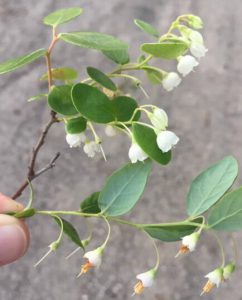
April is prime blueberry season in much of Florida with production spread throughout the north and central regions. Much of Florida’s commercial blueberry production relies on patented southern highbush varieties, but did you know that many native blueberries relatives can be found throughout the state?
Blueberries are in the Ericaceae, or Heath Family. This consist of 70 genera and more than 1,900 plant species, including roses. Plants in this family tend to be woody with bell-shaped flowers. They are commonly found in acidic, well-drained soil, much like those of Florida’s sandhill communities. Interestingly, the Ericaceae family has also been shown to have a unique mutual relationship with the ericoid mycorrhiza fungi. It increases plant roots access to water and nutrients.
Southern highbush hybrid
Included in this family is the genus Vaccinium, where our cultivated southern highbush belongs as a hybrid of several species: V. corymbosum, V. darrowii, and/or V. virgatum. The combined properties of the hybrid improve fruit production under low chill hour conditions but require lower pH and higher organic matter content than native varieties.
Native southern highbush cousins include: Darrow’s blueberry (V. darrowii), deerberry (V. stamineum), Elliot’s blueberry (V. elliottii), highbush blueberry (V. corymbosum), shiny blueberry (V. myrsinites), and sparkleberry (V. arboretum). Deeberry is my personal favorite. It is named so because deer enjoy nibbling on the plants when they are young and eat the berries of mature plants.
Lessons from the natives
Researchers are taking lessons from the native sparkleberry and working to incorporate it’s best features to improve blueberry cultivars and production systems. For example, the UF developed Meadowlark cultivar includes sparkleberry genetics and research has shown improved nutrient uptake on sandy soils in trials grafting southern highbush budwood on to sparkleberry rootstock. Sparkleberry’s tree like growth habit is of particular interest because of it’s improved architecture for mechanical harvesting, which could significantly reduce labor costs on Florida farms.
So other than a botany lesson, what is the point of this story? Before starting a blueberry farm or expanding your existing farmland, give a nod to these natives. Although southern highbush cultivars will likely require large additions of pine bark to the soil their native cousins may be just a scouting walk away in your area.
Check out details of Southern Highbush cultivars at https://edis.ifas.ufl.edu/hs1245
Thinking about starting a farm? Visit the UF/IFAS Small Farms and Alternative Enterprises website beginning farmers page for tips on getting started.
 0
0
